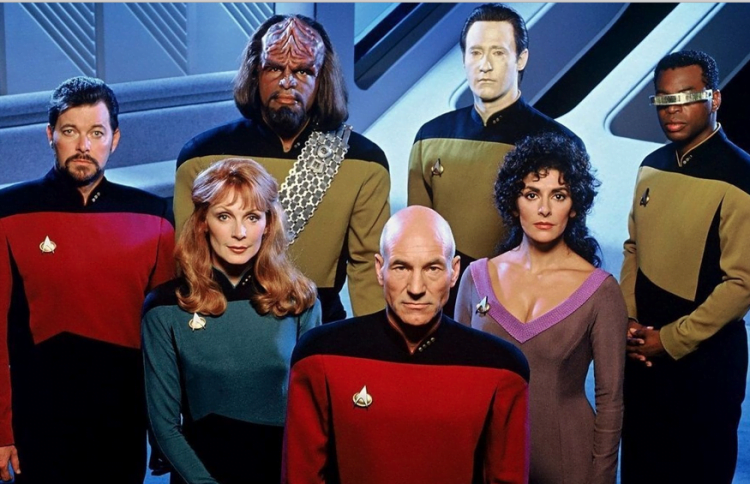
“Star Trek” is a multi-generational show with fans and creators having watched the series through multiple generations. With this in mind, there should be no surprise that quite a few creatives out there have pitched scripts for one iteration of the show or another over the years. Now, we get to take a look at failed script pitches by eight creatives that had tried submitting their work to ‘Star Trek: The Next Generation,’ ‘Star Trek: Deep Space Nine’, and ‘Star Trek: Voyager.’
The reason that so many names were able to pitch their scripts is that “Star Trek” once had an open-submission policy for their shows so that any writer could send in a script for approval. This helped launch the careers of countless creatives, but obviously, this means that there was a slew of rejections were sent out. Harry Werksman (‘Castle’,’Grey’s Anatomy’) even joked about this saying, “I spent so long pitching those fuckers before and after selling something.”
Let’s beam into the minds of some of the writers who did submit and see some of the concepts that were never able to find their way into production!
Star Trek: The Next Generation
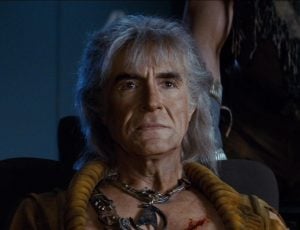 Marc Bernardin (‘Castle Rock,’ ‘Alphas)’:
Marc Bernardin (‘Castle Rock,’ ‘Alphas)’:
“It was called “Past Present.” The basic thrust of it was that, during one of what had to be many stretches where the Enterprise was just flying between worlds — Star Trek always pretended that space was a crowded place, when in reality, even with warp capabilities, the distance between populated systems is impossibly vast — Picard was concerned about the crew’s level of preparation. Even though the Enterprise wasn’t a warship, a knife still needs to be kept sharp. Picard vented his frustration to Data, who can’t share his concern, as circuits don’t get dull from lack of use. Later, there’s an attack on the Enterprise, from seemingly out of nowhere. It cripples the ship. The culprit: Khan Noonien Singh. Somehow, delivered from the clutches of the Genesis device (which does, after all, create life out of lifelessness) and pitted against a new generation of Starfleet captain. I don’t remember the ins-and-outs of the plot, but the upshot was that Data took Picard’s musings as an order and created a simulation that would challenge the entire crew — with a little holodeck trickery and inertial dampener manipulation, Data turned the Enterprise into a big-ass motion simulator ride.”
Jose Molina (‘Firefly,’ ‘Agent Carter’):
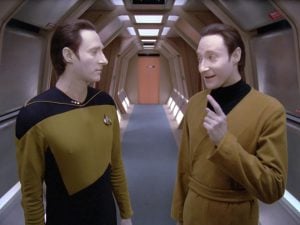
“The spec was called “Endangered Species” and was written near the end of TNG’s sixth season. It features the return of Lore, who seeks out Data with a dual purpose. First, he wants to return the emotions chip he stole in the season-four episode “Brothers,” and second, he wants Data to deactivate him. Yes, the “issue of the week” was assisted suicide. In returning the emotions chip to Data, Lore cautions him about the human feelings he so desperately wants. He explains that it was the overwhelming torrent of emotion from his own chip that once made Lore so dangerously unbalanced, and that now makes him want to end his life. Because just like the twin androids can process millions of calculations in a second, they can also feel millions of emotions in that time. The androids can experience lifetimes of human anguish in minutes. Data has an opportunity to reflect on his brother’s crisis as he mounts a holodeck presentation of “Frankenstein.” The Monster’s Promethean rant against his maker, and the sheer agony of his solitary existence, help Data arrive at a better understanding of his long-suffering brother. In the end, Data helps Lore find a new lease on life; he tasks his big brother with acting as caretaker to a species as unique and misunderstood — and endangered — as himself. Alone in his quarters after dropping Lore off at his new home, Data faces his own dilemma: Does he install his long-lost emotions chip? Heeding his brother’s warning, he crushes it under his boot instead.”
Naren Shankar (‘The Expanse’,’Grimm’) had a very out of body experience which could have made for either an extremely interesting or an excruciating episode. Like Molina above, this one has a pure focus on Data in a leading role:
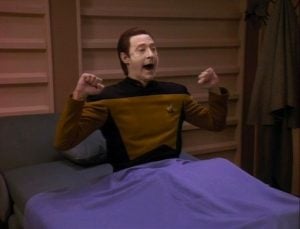
“I tried to find the script actually, and I couldn’t. There’s been so many generations of technology that even having the file; I’m not sure I could ever re-create it. But I believe the first spec I wrote for Star Trek was called “Blackout,” and it was a story about a massive power outage on the Enterprise. What happened was Data got zapped some way, and he started to dream. And the idea was: Can an artificial life-form and android actually experience dreams, and if so what do they mean? I’d read this really interesting article in the Atlantic about a neurobiologist who was talking about dreams in the context of kinda refuting Freudian dream theory. It just talked about the random firings of memories in your brain. And so it suggested an interesting angle into something that hadn’t been explored at that time with that character, Data. I suspect a lot of people wrote specs about Data, ’cause he was one of the most interesting characters on the show. And you’re always able to use him as a way of commenting on human behavior or aspirations. I seem to remember I didn’t want it to be like the holodeck, so it wasn’t like a literal dream — it was more impressionistic than that.”
Jane Espenson (‘Buffy the Vampire Slayer’,’Once Upon a Time’) made it in the door with a pitch idea which went along these lines:
“The only [spec] whose plot I recall at the moment was the one that got me invited in to pitch at the show. It was about Data using the holodeck to put himself in situations calculated to evoke strong emotions, hoping to feel happiness or love … but when the simulation goes awry (someone reprogrammed it? I forget), he does get a taste of emotion, but it ends up being anger. He has to confront the downside of being like a human being — not all emotions are positive. It reads like it sounds — a fun little thought experiment, certainly not enough to provide the spine of an episode. But it got me in the door!”
We’ve got an interesting team up with both Troi and Geordi from Lisa Klink (‘Hercules: The Legendary Journeys,’ ‘Roswell’) that didn’t get her a spot on ‘Star Trek: The Next Generation’ but opened the door for future endeavors:
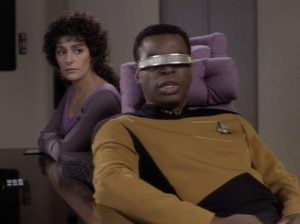
“In 1993, I wrote a spec TNG episode called “The Empath.” The crew needed to get information from an alien race about how to get through a dangerous part of space. But the aliens only communicated telepathically, so the universal translator was no help. Troi couldn’t understand them either. However, the neural interface of Geordi’s VISOR allowed him to perceive their thoughts. The problem was that these aliens were highly emotional, and Geordi found it overwhelming. So he turned to Troi for advice about how to handle and interpret the emotional overload. My idea was to take the chief engineer completely out of his element and force him to solve a different kind of problem, leading to some reflection about why he chose to work with machines instead of people, and why his best friend was an android. It was a perfectly good episode if nothing spectacular.
The script did get me invited in to pitch stories to Deep Space Nine, which led to my writing an episode for them and getting hired on Voyager.”
Star Trek: Deep Space Nine
‘Daredevil’ showrunner Steven DeKnight had attempted to get into the Trekkie action while we were watching a new form of “Star Trek” aboard a space station. This is probably my favorite of all the pitches in this list:
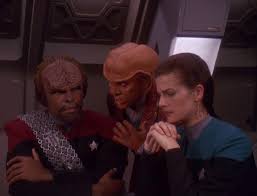
“I wanted to do something that was fun and a little bit different. The spec was called “Giant.” It starts out in Quark’s bar, and Worf is there with Jadzia Dax. He goes up to the bar to get a drink, and he comes back to the table to discover there’s a Ferengi hitting on his girlfriend. He tells the Ferengi to get lost and the Ferengi gets feisty. Worf says, I remember this line, “There’s no honor in fighting a single Ferengi.” And he hears a voice behind him saying, “I’d say the same thing about Klingons.” And he turns around, and there’s a giant Ferengi behind him that’s bigger than he is. So that’s the start of it, and when we come back, it’s your classic bar fight with Worf and this giant Ferengi, who goes toe-to-toe with Worf. And from there, everybody gets thrown into the brig.
You find out as the story unfolds that these two Ferengi’s are brothers, the regular Ferengi and the giant Ferengi. The big one is a scientist, and he discovered there’s a secret the Ferengi have been hiding for like a thousand years: The Ferengi used to be big, they used to be like Klingons. And slowly they evolved, they got smaller, and basically sneakier, as an evolutionary survival tactic. Because, as you find out in the story, people underestimate you when you’re small. They don’t consider you a threat. And that’s how you can screw them over. So the scientist discovered that there’s a genetic modification he can make to restore Ferengi to their rightful place. And he has this dream of Ferengi’s becoming large again and being respected.
The story from there basically goes that Worf and Dax have to transport these two guys, because they’re wanted fugitives from the Ferengi empire, and hand them over. And on their way transporting them, they get attacked by a Jem’Hadar ship. From there it becomes this adventure, as they crash land on this planet, of Worf and Dax having to work together with these two Ferengi to get off the planet and escape the Jem’Hadar. And at the end of the episode, Worf has gained a lot of respect for this giant Ferengi. And he lets him go. He helps him escape.”
Star Trek: Voyager
It is hard to imagine bringing in “Star Trek” from TNG and on without having a Borg pitch and this one by David H. Steinberg (‘Space Racers,’ ‘The Simpsons’) not only does that but makes reference to ‘Deep Space Nine’ as well!
“Wanting to prove her worth as an engineer, and referencing Borg transwarp conduit, the natural wormhole at Deep Space 9, and the Cytherian’s technology, B’Elanna theorizes that a multi-phasic tachyon generator could generate an artificial wormhole to get them home in one jump.
But when she convinces Janeway to try the new device, it works, a little too well … sending them billions of light years to another galaxy on the other side of the universe. No Federation ship has ever ventured outside our own galaxy, and this distance would take literally millions of years at top warp. What’s more, the galaxy they’ve traveled to is far older than our own, with only white dwarf stars remaining, and therefore devoid of life as we know it.
B’Elanna is devastated and reveals to Tom Paris that as the engineer, she feels the weight of responsibility to come up with a solution that will get them home. Suddenly, the Doctor starts to flicker. His program is failing. Soon the rest of the ship functions start to lose power as well. Tuvok concludes that the extreme age of the galaxy has caused certain constants of physics to “degrade” and the ship will lose life support in days.
B’Elanna needs a power source to create a new wormhole, but without the warp engines, she has no way to do it. Until she realizes that the white dwarf stars are the key. Harry Kim references metaphasic shields to enter the star’s corona to collect the radiant energy. As the crew plans the approach, Neelix discovers the Doctor flickering in sickbay and thinks there’s more to it than just power fluctuations. Together with B’Elanna, they realize the flickering is a coded message.
With time ticking down and ship’s functions failing, the crew enters the star’s corona and siphons the energy into the deflector dish. They engage the tachyon emitter only to see the energy dissipate uselessly into space. Just then, a ship approaches. It’s the Federation Starship Nebula, captained by Janeway’s roommate from the academy. She beams aboard, and Janeway quickly deduces that she’s not who she says she is. Here, the Being reveals that long ago her species evolved into pure energy (I had to go there, nod to TOS) and tried to communicate through the Doctor. Janeway asks if they can help them return to their own galaxy, but the Being looks confused.
Clearly, the crew doesn’t realize what’s happened to them. They are in their own galaxy, the star they entered is the Sun, billions of years into the future.
The Being is what all life in our galaxy evolved into. The ship’s computer assumed time was a constant and got a star fix based on the current position of the stars, not accounting for drift and movements over such a huge amount of time. The Being helps them undo the wormhole, but since the phenomenon must be symmetrical, the ship is returned back to the Delta Quadrant. B’Elanna realizes it’s a team effort, and that she’s not alone in trying to get home.”
This one has some great views of evolution and nods to other series from the franchise. It is a fun read though I’m not sure how well it would have translated to the small screen to keep audiences interested.
Finally, we have a pitch by Marc Guggenheim (‘Arrow,’ ‘Legends of Tomorrow’) which sounds like it could have been an action-filled thrill ride:
“Captain Chakotay and the crew of the Voyager encounter a space-time anomaly with what appears to be a Federation Starship from the future. On it, they find their lost Captain Janeway (in stasis) and Admiral Janeway, Kathryn Janeway from 20 years in the future. Admiral Janeway offers the crew what they want most — a way home with the help of future technology, explaining the time paradox by the revelation that her future self was always meant to come help them. Chakotay and Tuvok begin to suspect that Admiral Janeway and her crew are not what they seem, and find they’re actually Shapeshifters impersonating a Federation Starship. By taking the form of the Voyager’s crew, the Shapeshifters are able to take the entire crew hostage. The Voyager crew must work together to stop the Shapeshifters and save the real Captain Janeway.”
These are just a drop in the bucket of the various scripts which were rejected from “Star Trek” over the years, and it feels like a set of ideas which could easily be mined in future iterations of the franchise if the well of original ideas ever ran dry.
Which of these “Star Trek” scripts do you wish had seen the light of day? Share your thoughts in the comments below!
Source: Vulture
